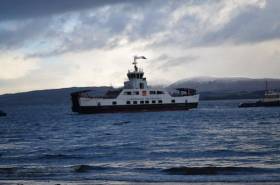Displaying items by tag: Fergusan Marine Newbuild
CalMac’c Newest 'Hybrid' Ferry Begins Advanced Sea Trials
#Newbuild - Scottish operator, Caledonian MacBrayne (CalMac) latest newbuild 'hybrid' ferry, MV Catriona, has begun advanced sea trials around the Isles of Arran and Cumbrae on the Firth of Clyde.
The hybrid ferry launched in December 2015, is one of only three sea-going passenger and vehicle roll-on, roll-off ferries in the world to incorporate a low-carbon hybrid system of traditional diesel power and electric lithium-ion battery power.
The diesel electric hybrid ferry will be carrying out real time trials this month on the Largs/Cumbrae route and at Lochranza/Claonaig. Trials will not affect normal timetabled service and no passengers will be carried.
Catriona is almost 30 metres long and can accommodate 150 passengers and 23 cars or two HGVs and is owned by Caledonian Maritime Assets Limited (CMAL).
It is the first ship to be built by the newly formed Ferguson Marine Engineering Limited (FMEL) in Port Glasgow and will follow the first two hybrid ferries MV Hallaig and MV Lochinvar into service with CalMac.
John Salton, Fleet Manager at Caledonian Maritime Assets said: "The trials are designed to balance the diesel and battery output to ensure best fuel efficiency. We expect to deliver the vessel to CalMac for operation soon after completion of the trials."
CalMac's director of operations, Drew Collier said: "We look forward to welcoming the MV Catriona into service following the successful conclusions of these trials."
The vessel will be officially handed over by owners CMAL in September. The vessel will be initially deployed on the Claonaig Lochranza crossing to meet increasing demand on this route from summer 2017.
Afloat adds that the same Clydebank yard, FMEL have also an order from CMAL for a pair of 100m long newbuild ferries, each with a 1,000 passenger capacity and 127 cars/16 HGV's (or combination).
The environmentally friendly 'duel-fuel' (LPG and marine diesel) powered pair are earmarked for the Ardrossan-Brodick (see port redevelopment) and the Uig Triangle routes. A final decision depends on deployment with CalMac and also from analysis of demand on the operator's main routes.























